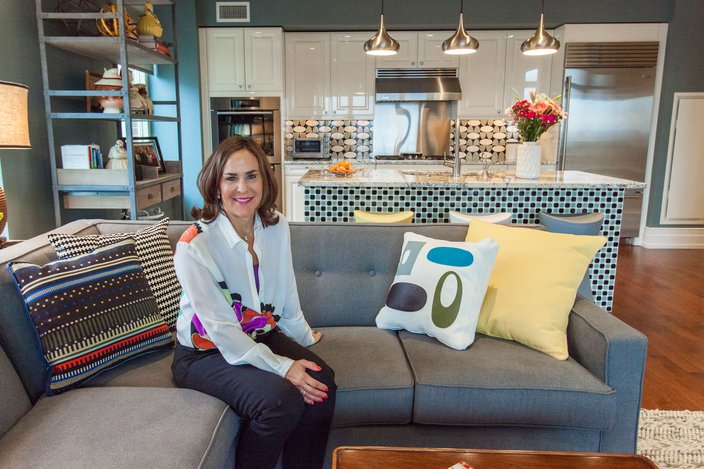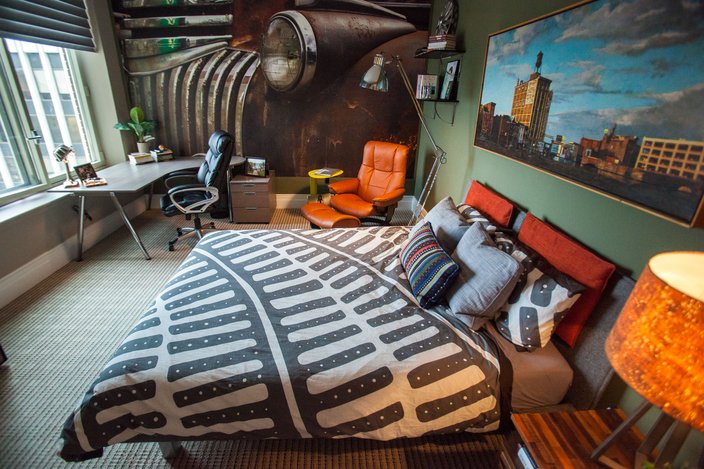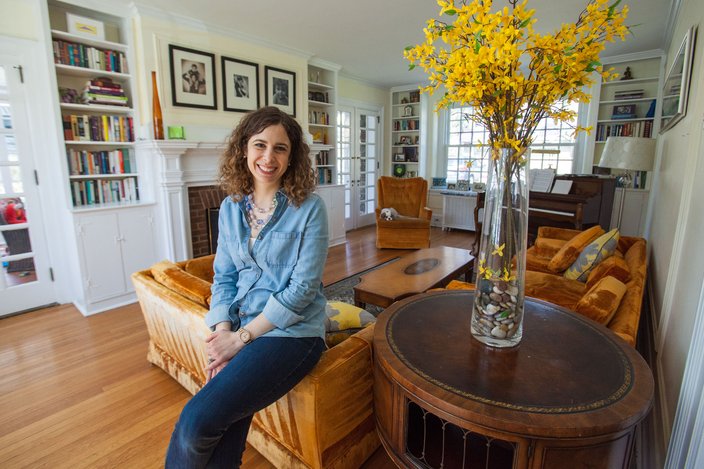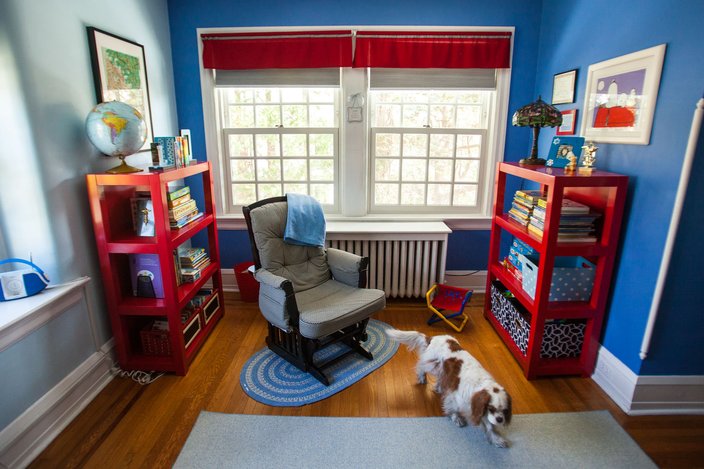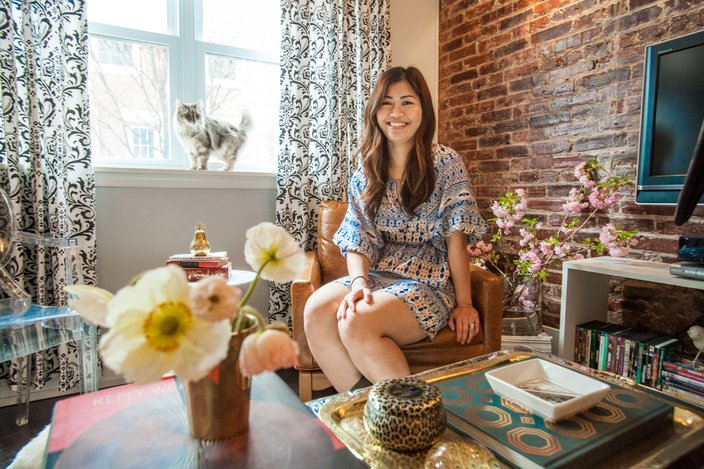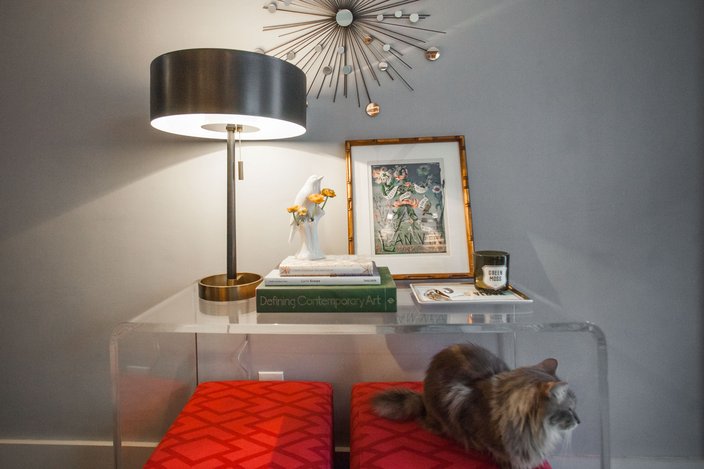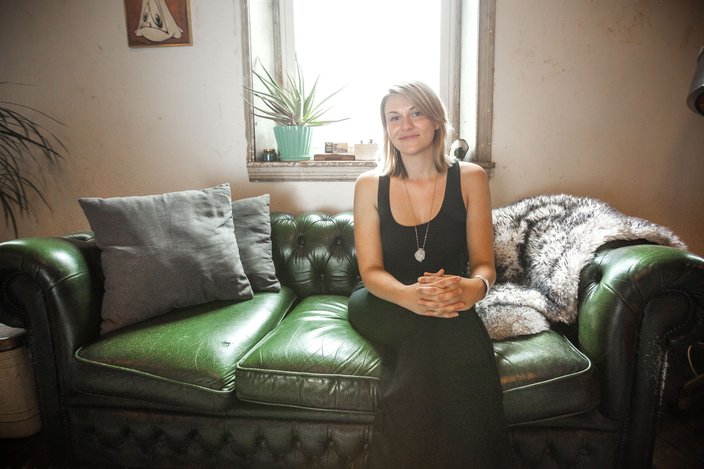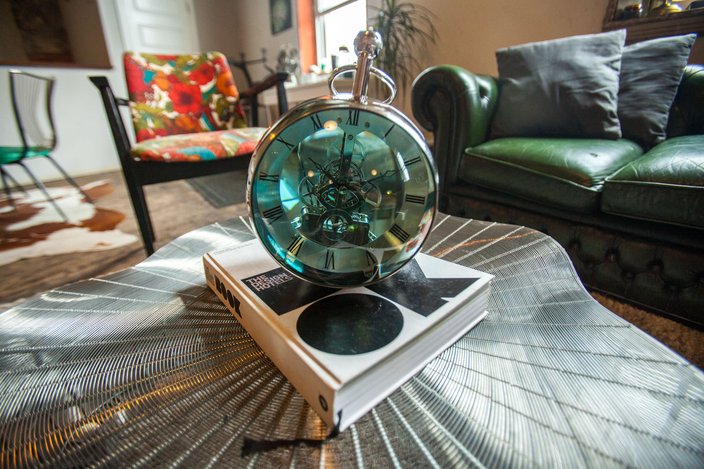Interior designers are the life coaches you hardly know you need. In theory, the whole concept sounds absurd: Money? For someone to tell me what to do with my space? Rubbish.
Yet, somehow, it works. They push objects on us that delight and inspire; they straight-talk us into packing away those unsightly objects we just can't bear to box up on our own; and, most importantly, they wade through the nitty gritty of our daily routines to shed light on the lives we never truly realized we were living.
But how are designers -- the coaches themselves -- assembling their spaces? Curious, we knocked on the doors of five Philly interior designers to get a glimpse of what lies beyond the threshold. Here's what we found.
Nile Johnson: The Great Experimenter
Nile Johnson grew up in a blue-collar town on the outskirts of Baltimore -- a time when he recalls not having a clue what to call his passion for interior design. He describes it as a Dark Ages sort of time for him -- one that was pre-HGTV.
"I knew what an architect was, but I didn't want to do that," he told PhillyVoice. "As long as I can remember, I liked to rearrange the furniture and that sort of thing, but I didn't know what it was called until I went to undergrad in Philly."
After graduating from the Art Institute of Philadelphia in 2007, he worked for a handful of area firms before scoring a design-competition spot in the short-lived HGTV program, "
Showhouse Showdown." (He won, in case you're wondering.) The show itself bombed, but it gave him the hustle to start his own business in 2012.
That coupled with his frustrations working with firms that, he says, lived in denial about recession and post-recession consumer spending.
"This is a luxury service, not a necessity, so you have to show yourself as a necessity -- the same way you call a doctor or a lawyer, you have to call us," he says. "We need to be shown in that light."
Company Specialty: Residential and boutique commercial spaces (for small businesses).
Approach: "What I tell clients when I meet them is that my job is to help articulate my style through their filter," he says. "It's almost like being in a town where you're a tourist: You know the attractions to see, you just don't know the most scenic way to get there. I'm the driver, so rather than doing back alleys, I'll take you down the more beautiful road and still get to the destination you've set out for." For his own home, he takes the approach of "eclectic" -- it's a place for him to experiment, switching up rooms every six to nine months, taking, say, a love seat from the guest room and relocating it to the living room. (The ornate wooden chair pictured, for example, has lived in every room of his house.) His entryway space is the most emblematic of his experimental nature, serving a "four-zone" function: one zone for client meetings, one for his work area, one for an assistant's work area and another for library tools and lounging. "It's not just my home," he says, "it's my laboratory."
Preferred Color Scheme: Johnson says his flavor-of-the-moment color schemes are combinations of cobalt and orange, coral and tan, and plum and black.
Textile of Choice: Wools and velvets. "They give a room warmth and depth," he says.
Favorite Piece: His tufted, Chesterfield leather sofa. "It's classic, it's timeless, it can go anywhere, and it only gets better looking with age," he says.
Ellen Farber: Maker of Masculine (But Not Too Masculine) Spaces
Ellen Farber in the living room of her Rittenhouse Square condo. Farber designed her space with the view of Rittenhouse Square in mind. Thom Carroll / PhillyVoice
For Ellen Farber, designing is her second career. She began as an accountant but went back to school after seeing a newspaper article about interior design. She was inspired by textures, colors and trends.
"My favorite thing is following trends in the commercial area: What's going on? What are people talking about? How does that affect residential life?" Farber says. "You may go in and think you like something, but there could be specific features you're not aware of that help shape your experiences [in your home or office]."
So, consider Farber a tour guide through the decorative unconscious. She launched
Ellen Farber Strategic Design in 2012, after two years of working at commercial design firms. At present, she's working on developing an online platform showcasing commercial materials -- aka, a digital showroom.
Company Specialty: Residential and commercial, with a focus on organizational change and keeping up with trends.
Approach: The ultimate aim for her home was warmth. To accomplish that, she used metals and textures that are "masculine but great for everyone," satisfying her palate for an industrial look while using warm colors to mitigate the masculine effect -- so it's not "too startling," she says. For clients, she considers feelings first and foremost. "It's like clothes: The environment you're in impacts how you feel," she explains. "It really affects people. ... Design is about efficient use of space and space that makes sense for your life."
Touches of orange colors added to the bedroom of Farber's son allow the space to pop, making the space feel industrial but not cold. Thom Carroll / PhillyVoice
Preferred Color Scheme: She goes for neutrals with strong pops of color, but her latest go-tos are white, black, gray, yellow, red and royal blue. For her personal designing, she loves orange. "My entire house used to be orange, but now just my bedroom," she says. "I wouldn't buy a car that's the same color, you know? So I want variety."
Textile of Choice: Natural fibers, "lush textures" and patterns.
Favorite Piece: "My living room," she says. Particularly, Juliette doors that open up to her view of Rittenhouse Square -- the jump-off point for how she designed her home.
Amy Cuker: Connoisseur of Color
Amy Cuker in the living room of her Elkins Park home. Her sofas are hand-me-downs from her parents that, she says, give the room a lived-in, vintage feel. Thom Carroll / PhillyVoice
In the case of Amy Cuker, crafting interiors practically feels like it's coded in her DNA. She considers herself fortunate that she came from a mother who was an artist, someone who understood her passion -- encouraged it, even.
"I never had anyone say, 'Don't pick interior design as a career! That's not practical!'" Cuker laughs. "It actually seemed practical, because it was artistic and you could make a living -- plus, you need math and spatial skills."
Originally from North Jersey, Cuker, who owns down2earth Interior Design, attended Cornell University for interior design and, upon wrapping up her MBA program, drafted a business plan. She moved to Philadelphia in 2006, purchased her 3,500-square-foot home in Elkins Park and launched her business in 2010 when it finally occurred to her that the business plan she'd pocketed for years was a perfect match for her new life as a mother of two.
Company Specialty: About "95 percent" residential, but her background is in commercial design.
Approach: She has a fastidious eye with her own space's design. It's an instinct that, she says, never turns off. "I can be looking around while reading to my son and letting ideas marinate," Cuker says. "[When designing my home], I treat us like clients, in that we have a set of goals we're trying to accomplish and an aesthetic process -- I start the floor-planning process and research much in the way I would a client." But, she says of designing her particular home, she was fortunate to have a skeleton to work with that left her with a childlike eagerness. "Inheriting great architecture," she says of her 1929-built home, "is a gift."
Cuker mixes shades of blue and a pronounced red in her son's bedroom. Thom Carroll / PhillyVoice
Preferred Color Scheme: She's a gal who loves color in her personal spaces -- unabashedly so. "My home is a little more colorful than where most clients would want to go," she says. "A client probably wouldn't call me for an all-beige interior." She prefers her interiors to look like a watercolor painting, she says, where colors in a room are saturated and on a gradient.
Textile of Choice: Because she and many of her clients are part of young families, she's accustomed to using textiles and fabrics that are stain-resistant. She explains: "We tend to do a lot of our upholstery in mid-tone colors and cleanable fabrics that are forgiving, and then save our really stunning textiles for things like window treatments or accent pillows."
Favorite Piece: The medicine cabinet in her master bathroom. "The depth of the windowsill and the elegant curve make it look really substantial," Cuker says. "That's hard to achieve in homes constructed more recently."
Sary Em: Blender of Old and New
Sary Em, interior designer and owner of HOME Furnishings Boutique, in her Passyunk Square living room. Thom Carroll / PhillyVoice
Sary Em self-describes as a creative type. Growing up, she played violin, figure-skated, sewed, baked and, of course, designed -- fashion, mostly. But when college came around, she took a chance on architecture, only to later realize it was the inside of the home she was most interested in.
So, she pivoted.
Em graduated with her master's degree in interior design from Drexel University in 2006. She spent a decade with a commercial design firm in Philadelphia before getting laid off when the recession hit -- a blow, to be sure. Reacting quickly, she and her husband (an architect) decided to open their own firm, re(work),
within a year.
The joy for her as a designer, she says, is her environment -- one that feels very "small-town" (she's mostly referring to
her East Passyunk Avenue furniture boutique) and full of clients who aren't always of the predictably deep-pocketed variety.
"I think people think of an interior designer as someone only used by the rich, and I don't necessarily think that's true," Em says. "Anybody can hire a designer, whether it's to pick out wallpaper or redo their entire house -- I have a ton of clients in South Philly who have smaller homes, and they want a house that feels put-together without spending on the big budget."
Still, because her firm is a collaborative project with her husband, their combined skills are especially useful for a holistic approach to space-making -- ideal for major reworkings of long-empty townhouses and vacant lots.
Company Specialty: Residential, though Em says she sometimes misses the commercial work she'd do for her pre-recession firm.
Approach: Her home aims for open and airy, with mirrored coffee tables and a large mirror on one wall to reflect light -- particularly helpful for a rowhome that has few windows. "For my own space, because I already have a base, somewhere to start -- pieces I already love -- I'm not redoing the entire space. I'm just picking pieces here and there and incorporating them," she says. "With most clients, we'll usually look at the entire space as a whole." She prefers mixing vintage pieces with new ones, she says, because every client -- not to mention herself -- has a collection of sentimental items they refuse (refuse) to leave out of their design plan.
Em uses mirrored and acrylic furniture to help her small living space appear more open, airy and spacious. Thom Carroll / PhillyVoice
Preferred Color Scheme: Gray -- especially when used with fuchsia. "My initial reaction to everything is 'gray everything,'" she jokes.
Textile of Choice: Velvet. "It's beautiful, luxurious and it feels amazing," she says.
Favorite Piece: The "Louis Ghost" chair in her living room, which is made of acrylic. "It's a great representation of my personal aesthetic -- a mix of contemporary and traditional," she says. It was also a gift from her boyfriend (now husband) when she graduated -- consider it one of those sentimental knick-knacks that refuse to leave a space.
Amanda Shoulson: Nature's Integrator
Amanda Shoulson in the living room of her 6,000-square-foot warehouse in East Kensington. Vintage furniture, succulent plants and original paintings by Philadelphia-based artist Yis Goodwin are prevalent throughout her space. Thom Carroll / PhillyVoice
Amanda Shoulson's motivation is simple: She loves to fix things. In her case, that fixing domino'd to building and then designing. When she graduated from high school, she volunteered for
Global Volunteers and went to Africa to experience working with communities and designing classrooms for children, which inspired her to continue on in the field.
What inspires her, she says, is anything from eye-catching textiles to the lining on a piece of furniture. Still, she says, her goal is always the same: She's in it to please.
"[Designing] is such an intimate thing -- people are inviting you into their home and telling you how they live their lives and telling you to create something for their ideal life," she says. "The best feeling in the world is seeing your client light up and knowing you got it right for them."
Company Specialty: Residential, with a focus on the luxury furniture of her firm and French furniture-making company,
Roche Bobois.
A translucent table clock and one of two iron tree coffee tables in Shoulson's common area. Both are from design firm and luxury French furniture maker, Roche Bobois. Thom Carroll / PhillyVoice
Approach: "My space is free-spirited," she says. "It's also inspired by nature, too, because I'm trying to bring the outdoors inside. There's a lot of plants and such throughout the space." Example: A set of "iron tree," wire cocktail tables that, to the casual observer, look like metal tree stumps. The indoors-turned-outdoors approach stems from her upbringing in upstate New York, where greenery was everywhere. "I was surrounded by nature all the time and got to be outside, and without that in my spaces, they don't feel alive -- they feel cold." With clients, though, she takes herself out of the picture and designs based on how they live their lives. "I'm the only one I have to please with my spaces, and my feelings change, and my spaces change with them," she says. "But with a client, you want it to be timeless."
Preferred Color Scheme: Industrial and rustic colors of blue and gray -- "but always with crisp, clean white walls," she says.
Textile of Choice: Sheepskin. (Yes, sheepskin.) "It's the kind of thing that can almost change a room," Shoulson explains. "It's a high-texture piece to mix in with leather and fabrics."
Favorite Piece: Her green, tufted, "smoker-lounge-like" Chesterfield sofa with rolled arms (pictured). "It's classic, and the workmanship and tufting that goes into a sofa like that is exceptional," she says. "That is what draws me to things: craftsmanship."

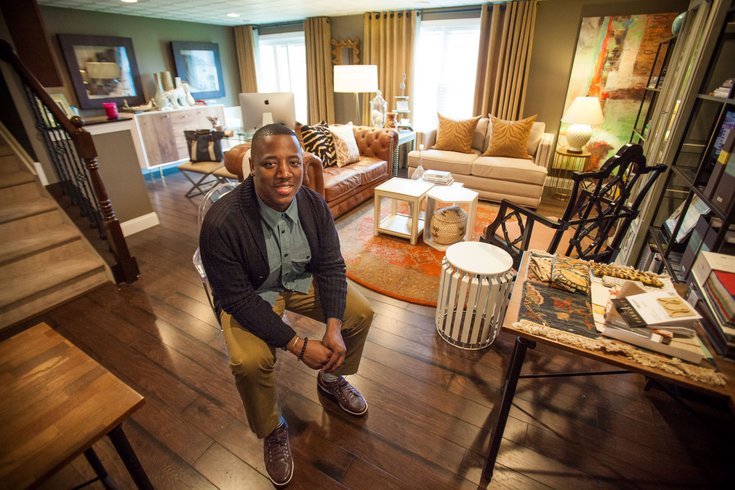 Thom Carroll/PhillyVoice
Thom Carroll/PhillyVoice
